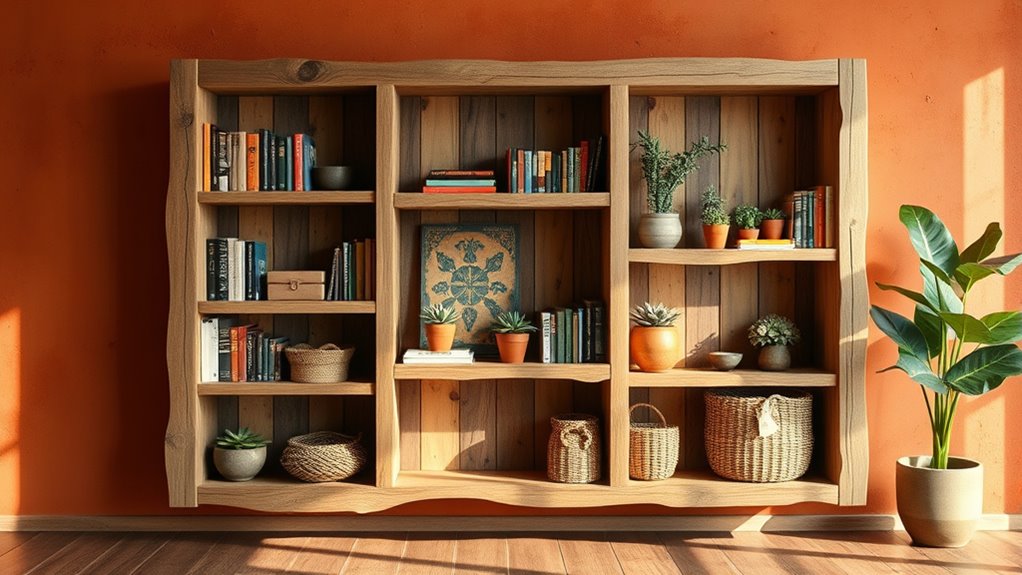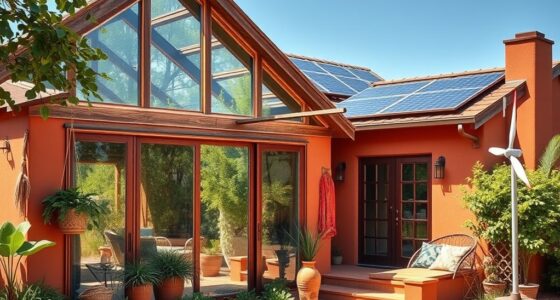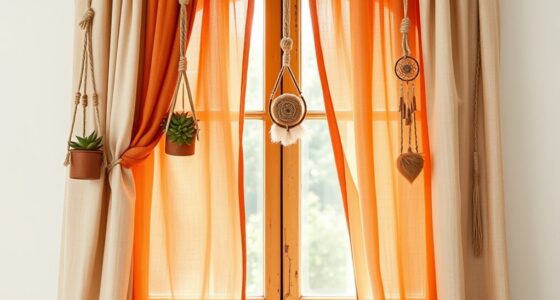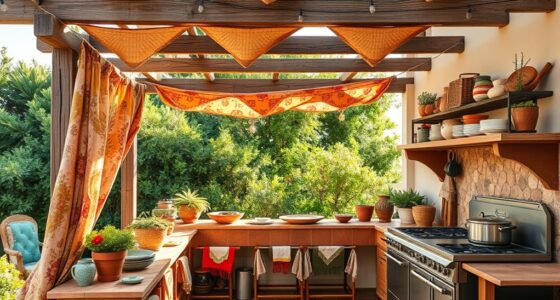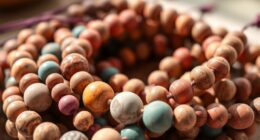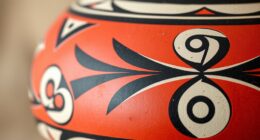To build a DIY boho bookshelf, start by sketching your design and measuring your space. Choose affordable, natural materials like poplar wood and add personal touches with woven accents or decorative items. Carefully cut and mark your pieces, pre-drilling to prevent splitting. Find wall studs for secure mounting and attach supports directly into them for stability. Finish with polyurethane for durability and a polished look. Keep going to discover detailed steps and tips for creating your perfect boho shelf.
Key Takeaways
- Plan your design with earthy tones and personal touches, ensuring it complements your decor and fits wall space.
- Select affordable, durable materials like poplar wood, and incorporate natural textures for a boho aesthetic.
- Carefully measure, mark, and pre-drill support holes for a sturdy, level bookshelf build.
- Secure supports directly into wall studs for maximum stability and safety.
- Finish with polyurethane and add decorative accents such as woven baskets and vintage items for a cozy boho look.
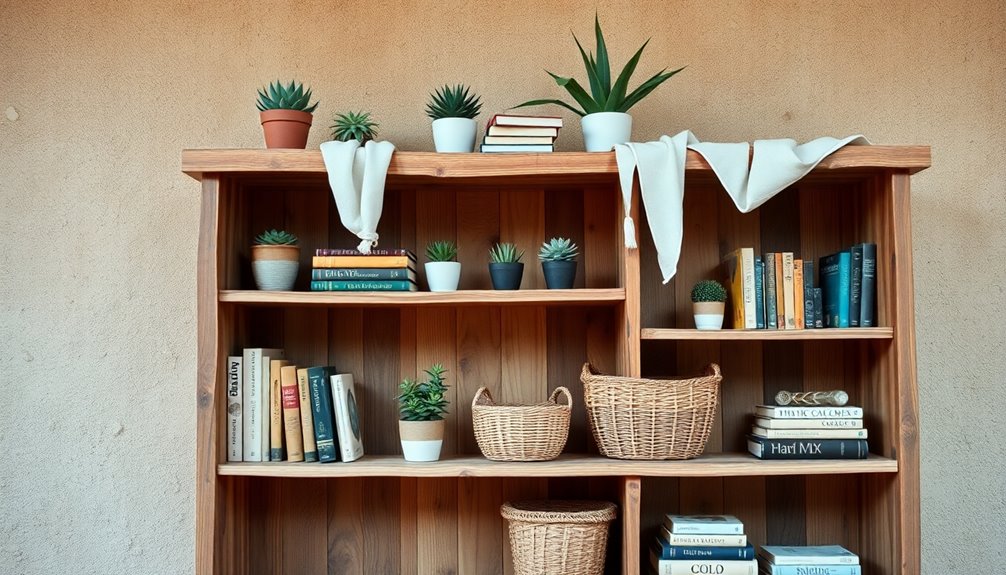
Creating a DIY boho bookshelf is a rewarding project that adds a stylish, functional touch to your space. To start, you’ll want to sketch out your design ideas, keeping in mind your wall space and the aesthetic you’re aiming for. Required fields are marked, so be sure to measure carefully and note down your dimensions before purchasing any materials. This planning stage ensures your finished piece fits perfectly and complements your decor.
When considering boho chic style, embrace earthy tones like warm browns, deep greens, and muted oranges. These colors create a cozy, inviting vibe that’s essential to the boho look. Don’t forget to add personal touches—think woven accents or small decorative items—to truly make it your own.
Using affordable materials is key, and poplar wood is an excellent choice. It costs around $40 for enough to complete the project, making it budget-friendly yet durable. When cutting your wood, start with the longest pieces first, which streamlines the process and minimizes waste.
Pre-drill holes in your shelves and supports to avoid splitting the wood later. Carefully mark the support locations with a pencil, ensuring they’re level and evenly spaced for a clean, professional appearance. Keep in mind that precise marking is vital for a sturdy, safe bookshelf.
When you’re ready to mount the shelves, use a stud finder to locate wall studs. Installing supports directly into the studs provides maximum stability and eliminates the need for extra anchors, which can sometimes be less secure. Securely attaching supports into the wall studs ensures your bookshelf can hold a good amount of weight without wobbling or falling.
Once everything’s in place, finish your project by sealing the shelves with polyurethane. This step enhances durability, protects the wood from moisture, and gives your shelves a polished look. Incorporating natural materials aligns with the boho style and adds texture to your design.
Finally, take a moment to enjoy your creation. The beauty of a DIY boho bookshelf is that it’s customizable—you can paint, stain, or leave it natural depending on your style. Adding decorative elements like small plants, vintage books, or woven baskets can elevate your boho chic vibe.
Next time you’re looking for a weekend project, remember that a simple, thoughtfully built bookshelf can transform your space into a cozy, earthy retreat. Keep in mind that patience during planning and installation will pay off with a stylish, functional piece that’s uniquely yours.
Frequently Asked Questions
Is It Cheaper to Build or Buy a Bookshelf?
You’re wondering if building or buying a bookshelf saves you money. Generally, building one costs around $40 in materials, while store-bought options range from $50 to several hundred dollars.
When you build, you can choose affordable woods and customize the size, saving money in the long run. However, building takes time and effort, so consider your priorities—cost savings versus convenience—before deciding which option works best for you.
What Is the Bookshelf Rule?
The bookshelf rule guides you to arrange items in odd numbers, usually groups of three, for a balanced and visually appealing display.
You should create triangular compositions, placing larger pieces at the back or bottom and smaller ones in front for depth.
This rule helps prevent clutter, promotes variety with textures and heights, and draws the eye smoothly across your shelf, making your space look organized and stylish.
What Is the Best Wood to Use for Built-In Bookshelves?
When choosing the best wood for built-in bookshelves, consider durability, cost, and appearance.
Poplar is a great option because it’s affordable, easy to work with, and has a beautiful finish.
Plywood also works well for strength and a sleek look.
If you want premium quality, oak or maple offers durability and elegance, but they come at a higher price.
Think about your budget and style to pick the perfect wood.
What Is the Difference Between a Bookcase and a Bookshelf?
A bookcase is larger, often built-in or enclosed, designed to store many books and decorative items, making it a focal point in a room.
A bookshelf is smaller, portable, and typically open, ideal for quick access and flexible use.
You’ll find bookcases more permanent with features like doors or glass panels, while bookshelves prioritize simplicity and accessibility for everyday use.
Conclusion
Now that you’ve built your boho bookshelf, you might worry about it looking too plain. But with just a few splashes of color or some decorative accents, you can transform it into a stunning statement piece that reflects your personality. Don’t hesitate to experiment—painting or adding accessories will make your bookshelf uniquely yours. Enjoy customizing your space, and remember, the best part is making something that truly feels like home.

